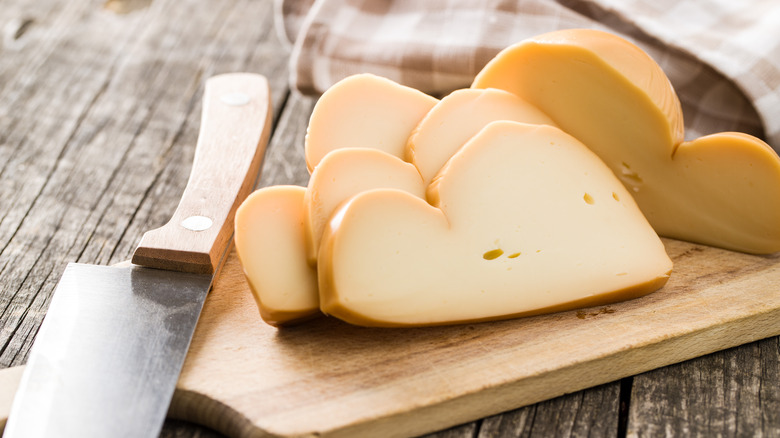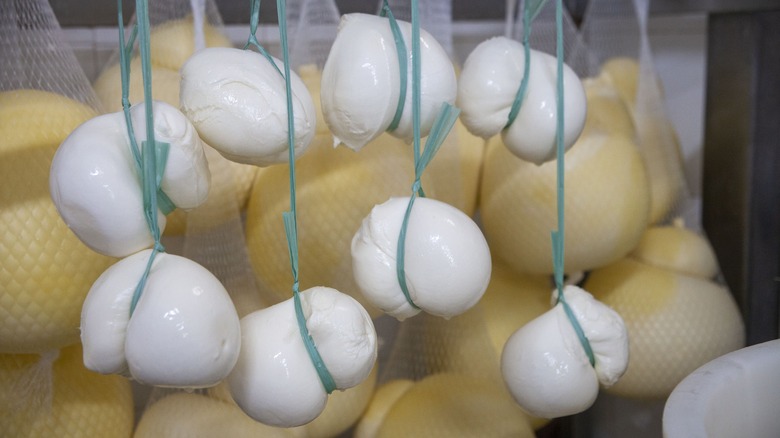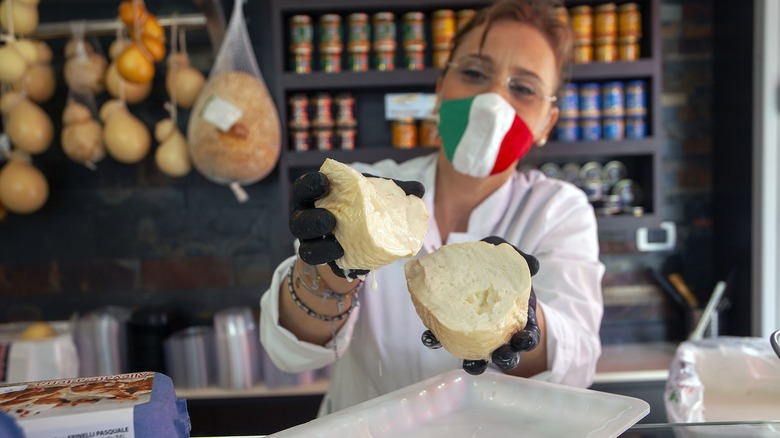What Is Scamorza Cheese And How Is It Different From Mozzarella?
Italy may well be a nation whose storied, lengthy history and nuanced culture is preceded by its culinary traditions and renown. When one thinks of the distinctly-boot-shaped country that juts out so prominently into the Mediterranean Sea, the scope and ruins of the Roman Empire and cradle of the Enlightenment come to mind. But, it is likely many first think of pizza margherita, spaghetti alla puttanesca, Prosciutto di Parma, and porchetta among other iconic gustatory gifts the Italians have developed and shared with a hungry world.
Like many of its European neighbors — we're looking at you, France — Italy is a nation in love with cheese. An admittedly-incomplete, but still expansive list of Italian cheese at Formaggio.it lists an impressive roster of 540 varieties, the best known of which are: the nutty, savory aged Parmigiano-Reggiano, the fresh and luscious mozzarella, and the assertive yet creamy gorgonzola. But there are many more that, though they don't have the same international acclaim, garner a devoted fan base just the same, such as the medieval, cave-born formaggio di fossa and the literally-infested casu marzu, the "most dangerous cheese in the world" according to CNN.
One Italian cheese you might have come across is scamorza. If you've seen it on restaurant menus, it may be listed in a dish that normally calls for mozzarella. While these two cheeses share many similarities, their differences are striking, so we're diving into just what makes them unique and how to get your most out of scamorza.
Similar but not the same
If mozzarella is the fresh, fun, easy-to-get-along-with-if-a-little-bland kid, then scamorza is its slightly edgier older sibling. Scamorza starts out much like mozzarella as both are spun cheeses of the pasta filata grouping (via Cheese.com). The milk used for scamorza is typically cow's milk, though some sheep milk can be added for flavor. How it differs most from mozzarella is that scamorza is tied and hung to dry for one to two weeks rather than being packaged straight from the briny bath. As you might imagine, this makes for a firmer, saltier cheese. Many scamorza are also quickly smoked over straw —making scamorza affumicate — adding a further layer of flavor.
The flavor of scamorza can be described as mozzarella, but more intense, says Food and Journeys. While not as sharp as aged provolone, unsmoked scamorza bianca retains the light, milky flavor of mozzarella, just more abundantly and with a more pronounced saltiness. Scamorza affumicate, of course, has an unmistakable (though not aggressive) smokiness that can lend an interesting note either to a cooked dish or a cheese board. It is important to remember that while scamorza is an aged cheese, it should be used quickly after opening as its delicate smoky flavor and aroma can rapidly fade.
Cooking with scamorza
The wonderful thing about scamorza being so akin to mozzarella is that the latter can be a guide as to how to use the former. If you are looking to up your homemade pizza game, give scamorza a spin rather than the usual cheese. It melts well, but offers a bit more oomph in the flavor category, so choose equally bold ingredients that will play well with the scamorza. Pizza Today suggests using scamorza affumicate to boost the smoky bona fides of an all-American creation, the BBQ chicken pizza.
If you're looking for a dish that features a bit more of a veggie bite and a lot more Italian flavor, consider melanzane alla parmigiana, which we tend to call eggplant parmesan stateside. The name is a bit of a misnomer as it usually features little-to-no Parmigiano-Reggiano. Rather the dish is typically graced with a meltier cheese, of which mozzarella is a common go-to. But as we mentioned, where you can use mozzarella, scamorza can easily be swapped in.
Scamorza shouldn't be overlooked as the star of the show, as it can easily headline a cheese board. Dispense with other cheeses and accoutrement, and try Cuisine Fiend's baked scamorza — a bubbly cheese served with pine nuts, pumpkin seeds, and arugula served atop garlic bruschetta.
Where to buy scamorza
Unlike its better-known Italian cheese contemporaries, scamorza is considered more of a specialty cheese. As such, it is likely harder to find than mozzarella and provolone, which can be had at most any self-respecting supermarket, though the quality may vary wildly. Those looking to get their hands on a piece of scamorza would be well-advised to search for a specialty cheese shop or Italian market in their area. Call ahead and see if they have what you're looking for, or roll the dice and wander the aisles in search of scamorza. You may well walk away with some other delicious finds you weren't expecting. If your quest turns out fruitless, don't be afraid to ask the shopkeeper if scamorza is a product they'd be willing to order special for you.
Speaking of ordering, we live in a gilded age of online shopping where one can, for a price, have most anything shipped right to their doorstep, and cheese is no exception. Online retailer Supermarket Italy offers three different entries varying in flavor and size. For a domestic option, Whole Foods' online operation sells Bel Giosi scamorza that is smoked over hickory wood.
More ambitious cheese lovers can also go the homemade route. As a fresher cheese, scamorza requires little in the way of specialty equipment or ingredients, explains The Recipe Hunters. Milk, a thermophilic culture, rennet, and a little bit of time and elbow grease are all that is required to make scamorza.



